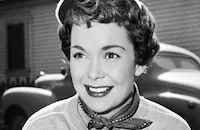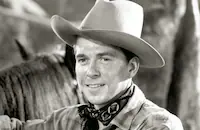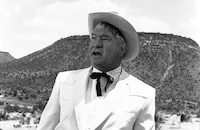Tugboat Annie Sails Again

Brief Synopsis
Cast & Crew
Lewis Seiler
Marjorie Rambeau
Alan Hale
Jane Wyman
Ronald Reagan
Clarence Kolb
Film Details
Technical Specs

Synopsis
Tugboat Annie Brennan, the shrewd and cantankerous skipper of the Narcissus , is engaged in a lifelong feud with rival Washington State tugman Captain Bullwinkle. Annie's hotheadedness places her in danger of losing her job as senior captain with the Secoma Towing and Salvage Company when the company's president, Alec Severn, is unable to pay a $25,000 bank note that has come due. When Alec leaves to discuss the note with the new bank president, he puts Annie in charge of the company, ordering her to stay away from the new shipyard owner, millionaire J. B. Armstrong. Annie stubbornly believes, however, that she can talk Armstrong into a fat contract and sets up a meeting with him. The meeting turns into a disaster when Annie, not recognizing J. B., throws him into a pile of fish and he cancels the salvage company's contract. Next, Bullwinkle sends Annie on a wild goose chase to aid a beached vessel that turns out to be a whale, but she turns her luck around when Bullwinkle is unable to float a ship that has gone aground and Annie successfully frees it for $25,000. With the company out of danger, Alec tells Annie to negotiate a job towing a dry dock to Alaska for Armstrong, but when Armstrong refuses to award the job to a woman, Annie appoints her old friend, Mike Mahoney, as captain and wins the contract. Annie is forced to take over the helm, however, when Mahoney shows up drunk and passes out. In addition to her problems with the ailing Mahoney, Annie finds that Peggy, Armstrong's spoiled daughter, has stowed away to be near Eddie Kent, Annie's ward. In the fog and rough seas, a ship rams the dry dock, and to save the dock, Annie is forced to beach it while she takes the sick Mahoney to the hospital. When a gleeful Bullwinkle claims the dock for himself, Alec fires Annie for negligence. As Annie is preparing for retirement, she remembers that maritime law declares that a dry dock is not a vessel and is therefore not subject to salvage laws, thus depriving Bullwinkle of his prize.

Director
Lewis Seiler
Cast

Marjorie Rambeau

Alan Hale

Jane Wyman

Ronald Reagan

Clarence Kolb

Charles Halton
Paul Hurst
Victor Kilian

Chill Wills
Harry Shannon

John Hamilton
Sidney Bracy

Jack Mower

Dana Dale
Josephine Whittell
Neil Regan
George Meader
Al Lloyd

Tom Wilson
Frank Hagney
Creighton Hale
Ed Gargan

Lucia Carroll
Eddy Conrad
Leon Belasco
George Campeau
Don Turner
Glen Cavender
Winifred Harris
Crew
Walter Deleon
Arthur Edeson
Leo F. Forbstein
Oliver S. Garretson
Edmund Grainger
Bert Hanlon
Harold Mclernon
Russ Saunders
Howard Shoup
Ted Smith
Jack L. Warner
Perc Westmore

Film Details
Technical Specs

Articles
Tugboat Annie Sails Again
Based on the real-life exploits of Tacoma, Washington sea captain Thea Foss who started her own barge company in 1889, Tugboat Annie Sails Again (1940), directed by Lewis Seiler, featured veteran actress Marjorie Rambeau in the title role. Rambeau had matured from her early fame as a celebrated Broadway beauty to become a reliable Hollywood character actress, and often found herself being cast as down-and-out women and alcoholics. Twice nominated for the Best Supporting Actress Academy Award, including one for Primrose Path which was released just before Tugboat Annie Sails Again, Rambeau was a skilled performer who found herself in a difficult place: trying to replace a beloved Hollywood actress in one of her most famous roles. One basic change was made to Tugboat Annie's circumstances she was now a widow operating her own in her tug business (Tugboat Annie had featured Wallace Beery as Annie's husband), sailing her boat the Narcissus out of fictional Secoma, Washington. Annie's chief rival in this sequel was the bluff and blustery Captain Horatio Bullwinkle, played by Alan Hale.
On board to play the requisite young romantic lead was Warner contract player Ronald Reagan, a steady presence by that time in over twenty features, playing both light and dramatic roles, including Brother Rat (1938) and Knute Rockne All American (1940), the movie he made just before Tugboat Annie Sails Again. The studio chose up-and-coming actress Jane Wyman as Reagan's love interest. Wyman and Reagan had appeared in several movies together before, and a real-life romance developed between the pair. The couple married in January of 1940 Reagan's first marriage but Wyman's third - and by the time Tugboat Annie Sails Again began filming in June of that year, Wyman was pregnant and beginning to show. Her baby bulge necessitated creative camera angles Wyman's belly was situated behind furniture and other actors placed to block her body in certain shots and a specially-designed wardrobe helped hide her condition.
The two younger actors were surrounded by a cast filled with veteran Hollywood character actors including Clarence Kolb, Charles Halton, and Paul Hurst (who had over 300 credits to his name when he died in 1958). Other cast members in Tugboat Annie Sails Again were Victor Kilian (who enjoyed belated fame on TV's Mary Hartman, Mary Hartman, and was sadly beaten to death in a 1979 home invasion), Harry Shannon, John Hamilton (known to all baby boomers as Perry White in TV's The Adventures of Superman starring George Reeves), and Chill Wills, who later became the voice of Francis, the Talking Mule and received a Supporting Actor Academy Award nomination for his role in 1960's The Alamo. Neil Reagan, Ronald Reagan's older brother who had a brief movie career, made his screen debut in Tugboat Annie Sails Again.
Tugboat Annie Sails Again utilized location filming at the nearby Port of Los Angeles, specifically the San Pedro Harbor area; it was the home of many busy wharves where authentic tug boat captains, along with other maritime workers, plied their trade. Ronald Reagan reportedly was delighted with the opportunity to pal around with the harbor denizens and thoroughly enjoyed the location work for the movie.
Reviewers were neutral to negative about Tugboat Annie Sails Again, all acknowledging the huge shoes that Rambeau had to fill in replacing Marie Dressler. Variety felt that the movie "displays neither freshness nor originality in its unfolding" and that Rambeau "overstresses in playing the role, and resorts continually to much mugging in an effort to catch attention." Time magazine called Rambeau "frog-voiced" and judged the movie "passable, not irresistible." The New York Times was less than impressed, deeming the movie "labored" and opining that the entire cast performed with "no more than a moderate competence in a film which is only fair."
Without the memory of the unforgettable Marie Dressler to beg comparison, Tugboat Annie Sails Again might have been appreciated for its own merits. Despite its tepid reception Warners did not make another Tugboat Annie movie - Republic Pictures tried out Jane Darwell in Captain Tugboat Annie five years later, and in the 1950s there was a brief syndicated television series about the character starring Minerva Urecal. Though a female ship captain wouldn't be quite the novelty today that it was then, Marie Dressler certainly set the gold standard by which all other Tugboat Annies would be judged, as Marjorie Rambeau found out in Tugboat Annie Sails Again.
Director: Lewis Seiler
Screenplay: Walter DeLeon; Norman Reilly Raine (characters)
Cinematography: Arthur Edeson
Art Direction: Ted Smith
Music: Adolph Deutsch
Film Editing: Harold McLernon
Cast: Marjorie Rambeau (Tugboat Capt. Annie Brennan), Alan Hale (Capt. Horatio Bullwinkle), Jane Wyman (Peggy Armstrong), Ronald Reagan (Eddie Kent), Clarence Kolb (Joseph B. 'Joe' Armstrong), Charles Halton (Alec 'Alex' Severn), Paul Hurst (Pete).
BW-76m. Closed captioning.
by Lisa Mateas

Tugboat Annie Sails Again
Ronald Reagan, 1911-2004 - TCM Remembers Ronald Reagan
Ronald Reagan, the actor turned elected official whose fascinating career saw him develop as a contract player for Warner Brothers studios, to a politician who fulfilled his ambitions by becoming the 40th President of the United States, died at his home in Los Angeles on June 5 after a long battle with Alzheimer's disease. He was 93.
He was born Ronald Wilson Reagan on February 6, 1911 in Tampico, Illinois to John and Nelle Reagan. When Reagan was nine, his family settled down in the small community of Dixon, about 100 miles west of Chicago. After high school, Reagan enrolled in Eureka College, a small Christian school near Peoria. He graduated in 1932 with a degree in Economics, and pursued a career in broadcasting. His first gig was as a part-time announcer at WOC in Davenport, Iowa. Within a year, WOC had merged with its big-sister station, WHO in Des Moines, and Reagan was hired as a sports announcer.
In the spring of 1937, Reagan drove to Southern California to catch the Chicago Cubs in spring training on Santa Catalina Island. While he was in California, he wrangled a screen test and signed a contract for $200 a week with Warner Brothers. His film debut was rather inauspicious; he portrayed a radio announcer in an innocuous comedy Love is on the Air (1937). He made a few more "B" programmers like Hollywood Hotel (also 1937), and Girls on Probation (1938), before getting his first prominent role opposite Bette Davis in the popular tearjerker, Dark Victory (1939).
Although he seldom got credit for being a good actor, there was no denying that Reagan held his own given the right material: Knute Rockne, All American as the doomed Notre Dame football hero George "The Gipper" Gipp, where he delivered the film's immortal line "Win one for the Gipper!"; Santa Fe Trail in which he ably supports Errol Flynn in one of the boxoffice hits of its era (both 1940); Kings Row (1941), featuring one of his finest performances as a small-town playboy whose legs are amputated by a careless surgeon; and Desperate Journey (1942) where he again supported Flynn in an exciting action picture.
Due to his poor eyesight, Reagan didn't see any action in World War II, so the studio heads assigned him to star in a series of patriotic films produced by the First Motion Picture Unit of the Army Air Forces in Culver City. Between 1942-45, Reagan starred in over 400 of these films. After the war, Reagan still found some good roles: The Voice of the Turtle (1947) proved he had a deft hand at light comedy opposite Eleanor Parker; The Hasty Heart (1949) offered another underrated performance as he ably portrayed the Yank in John Patrick's much heralded wartime play; and Storm Warning (1950) was a slick melodrama that cast Reagan as a crusading District Attorney determined to bring the KKK in a small southern town, with the help of Doris Day and Ginger Rogers!
It was around this time that Reagan became involved in politics. In 1947, he began a five-year term as president of the Screen Actors Guild (SAG), and testified in October of that year before the newly formed House Un-American Activities Committee (HUAC). He identified suspected Communists Larry Parks, Howard Da Silva and Alexander Knox, all of whom were subsequently called to testify, and subsequently blacklisted. Later records showed Reagan was so concerned about the Communist influence in Hollywood, that he became an FBI informer.
As Reagan became steeped in his political career, his parts throughout the '50s became inferior: the notorious Bedtime for Bonzo (1951); the coy "sex" comedy She's Working Her Way Through College (1952) that cast him as a college professor who romances a stripper! (Virginia Mayo); Cattle Queen of Montana (1955), a sluggish Western that even the redoubtable Barbara Stanwyck couldn't save; and finally Hellcats of the Navy (1957), a stodgy war picture that would be his only film that co-starred his wife Nancy (Davis).
Television offered some salvation. For eight years, (1954-62), Reagan served as the host of General Electric Theater, a televised series of dramas. He also found a niche as GE's goodwill ambassador to employees and to civic and business groups around the country, furthering his taste and honing his craft as a public official. By the mid '60s, Reagan would move into politics entirely, save for one last film, the thrilling The Killers (1964), Reagan's only known villainous role, as a murderous gangster. That same year, he actively campaigned for Republican Presidential candidate Barry Goldwater, although Goldwater lost to Lyndon B. Johnson.
Reagan whose profile was riding high, had cemented his future as a successful politician. In 1966, he ran against incumbent Governor Pat Brown for the state of California and won, serving successfully for two terms until 1974.
Reagan began an all-out, two-year drive to wrest the 1976 nomination from incumbent Gerald R. Ford, an appointed vice president who became president on the resignation of Nixon. Reagan fell short by a handful of delegates to the Republican national convention. But Ford lost to Jimmy Carter, and Reagan became the front-runner to challenge Carter in 1980. After defeating Carter, Reagan held two terms as President of the United States (1981-89). After his second term was over, he retired quietly in California. In 1994, it was revealed to the media that Reagan was suffering from Alzheimer's disease; he had been kept out of the public eye since then.
He was married briefly to actress Jane Wyman (1940-48), and had two children; a daughter Maureen and an adopted son, Michael. In 1952, he married a budding film starlet, Nancy Davis, who bore him two more children; a daughter, Patty; and a son, Ronald Jr. Ronald Reagan is survived by Nancy, Michael, Patty and Ron Jr. His daughter Maureen died of Melanoma in 2001 at the age of 60.
by Michael T. Toole
Ronald Reagan, 1911-2004 - TCM Remembers Ronald Reagan
Quotes
Trivia
This is the only movie that brothers Neil Reagan and 'Reagan, Ronald' ever made together.
Notes
According to a pre-production news item in Hollywood Reporter, Elsa Maxwell was to have been tested for the role of Tugboat Annie. Hollywood Reporter production charts add Granville Bates to the cast, but his participation in the final film has not been confirmed. For information on other films based on Norman Reilly Raine's characters, see entry above for Tugboat Annie.

Miscellaneous Notes
Released in United States Fall October 26, 1940
b&w
Released in United States Fall October 26, 1940














